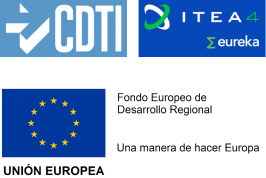- Urban Data Policy Lab: Policy & Data Exploitation & Re-use
- ITEA POLDER consortium: Accuro Technologies (project coordinator), Nommon, Quobis, FCC, Starflow, Vexiza, The Neon Project, Keypro, BEIA Consult International, SIS SA, ACD, ARD Group, ForteArGe, Mantis Software.
- 2018 – 2022

Context
Every time we carry out an activity through the use of information and communication technology (ICT), we generate a digital footprint. This interaction between users and ICTs gives rise to an unprecedented number of digital records, thus creating new opportunities for studying human behaviour. Recent advances in the storing and processing of large volumes of data enable the extraction of detailed information about people’s needs, activities and mobility from the analysis of data generated by sensors and personal mobile devices (smartphones, electronic transactions, social networks, smart cards, etc.). This information holds significant potential value for policymaking across various domains, such as transport, urban planning, energy, environment and health, among many other examples.
Smart cities are starting to use a range of data management platforms to leverage this data to meet their unique local needs. However, for cities to harness the benefits of innovative smart applications using big data, they shall collect and share the data in an interoperable and secure manner, as well as to process it in an efficient way to extract meaningful insights. Sharing can involve trusted partners, innovators, citizens to federal/state government bodies, adjacent communities, and other cities. The ITEA project POLDER (POLicy Data Exploitation & Re-use) aimed to assist governments in leveraging the new opportunities brought by big data.
The project
POLDER proposed a hybrid policy making model, where policy is made data-driven, model-driven and society-driven. The project delivered a series of methodologies for optimal combinations of several data sources in order to make the results:
- Cost-effective: collecting data for all types of decisions is usually very costly, even in a smart city, even in a context where sensors are cheap and connections are abundant. While actual data can provide a strong basis for evidence-based policies, the associated costs are not always feasible or even acceptable.
- Explainable: the outcome of algorithms may not be automatically understood by decision-makers, especially when state-of-the-art deep learning is used. Incorporating known models or actual experience from policymakers will help them to understand the results.
- Acceptable: when citizens’ opinions are included in policy making, it becomes much easier to demonstrate how citizens have actually influenced the policy and pinpoint where and how this influence has occurred. Stakeholders will recognize the points they raised, leading to an acceptable outcome.
Through a diverse set of use cases (on smart tourism destinations, smart mobility, air quality, temperature and noise monitoring, and environmental impact of urbanisation), POLDER aimed to contribute to improving the quality of life of citizens. Nommon’s participation in the project was focused in the tourism case study, which aimed to develop a tourism monitoring platform.
POLDER’s goals
The goal of POLDER was to design and deploy a software tool suite for data gathering, harmonisation analysis, and transformation to support governments in the elicitation, design, application, and validation of policy making. POLDER addressed smart cities and urban service providers in domains like logistics, health, energy, and other smart services such as smart tourism. The project tackled key challenges in smart cities by introducing intelligent ways to combine data from various sources, in a way that can be trusted, accepted and afforded. The following domains were covered by POLDER:
- By creating a better understanding of crowded locations in the city, POLDER aimed to reduce annoyance and unsafe situations for citizens.
- By understanding the physical conditions in a city — on aspects like temperature, noise and air pollution — through sensors and modelling, and relating these conditions to the local traffic situation, POLDER, through its visualisations solutions, aimed to assist in the selection of policy measures that would reduce traffic-related externalities, thereby improving health and well-being.
- By improving insight into tourist’s needs and managing their impact on a city, POLDER aimed to enhance the tourist’s experience, while minimising the impact they may have on the city.
- By expanding the development of smart city services into other domains, such as water or waste management, and thereby making government services more efficient and effective, taxpayers’ money would be used more efficiently.
Nommon’s role
Nommon’s participation in the project was centred in the use case of smart tourism. Tourism is one of the fields where the exploitation of big data can play an important role, opening up new opportunities for the design and implementation of services and public policies. Tourism can be a powerful tool to combat economic decline and unemployment, but it also faces significant challenges. The massive presence of tourists puts the conservation of natural, historical, and artistic heritage at risk, in addition to increasing pressure on infrastructure and public services, such as transportation and medical care, generating conflicts between residents and tourists. Addressing the needs of different groups while maintaining a balance between the interests of tourists and residents requires innovative designs and a transformation in the provision of certain public services.
To face these challenges, public bodies need integrated approaches that take into account the balance between a sustainable growth of the tourism sector and the quality of life of residents. In this context, the ability to know, understand and predict the patterns of the activity and mobility of tourists is essential, both for the formulation of public policies (e.g., to promote quality tourism, plan transport systems and other public services, manage large concentrations of tourists at points of interest, avoid negative impacts on the environment and heritage, etc.) and for the competitiveness of tour operators (e.g., allowing them to offer tailor-made plans for different visitor profiles).
The main objective of the smart tourism case study was the development of methodologies and tools based on the exploitation of massive data sources and machine learning techniques that allow the monitoring of tourist activity and the design and evaluation of new tourist policies and services. In this case study, Nommon collected data from several data sources (e.g., anonymised data from geolocated devices, data from open data portals and web services, etc.), developed and validated data analytics methods and algorithms for the analysis and prediction of tourists’ behaviour and flows, and specified and designed the Nommon-POLDER platform.
Results
POLDER offered a new perspective on data reusability in smart cities by providing a means to share knowledge rather than data. The primary innovation of the project was a distributed framework for data exchange and data reuse with brokerage tools and an open data platform, allowing parties to retain control of their data while still providing valuable information to others. This is aided by holistic city monitoring dashboards and explainable AI to increase acceptance and trust by decision-makers and citizens. The project demonstrated these achievements in four use cases: smart tourism (Nommon’s use case), smart mobility, air quality, temperature and noise monitoring, and environmental impact of urbanisation.

POLDER, with file number IDI-20191133, is a project financed by the Centro para el Desarrollo Tecnológico e Industrial (CDTI) and the European Regional Development Fund (ERDF). "A way to make Europe". Supported by ITEA, the Eureka RD&I Cluster.